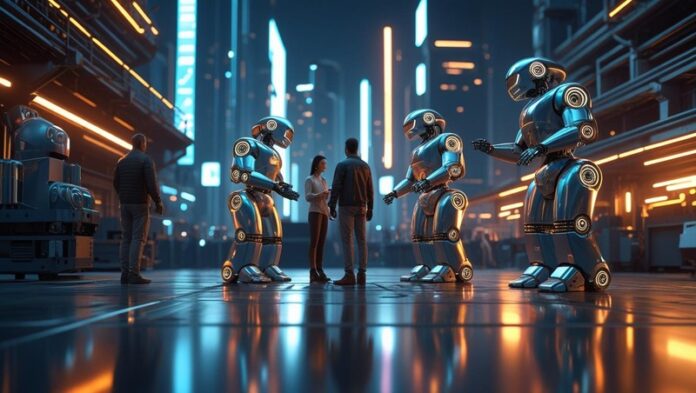The embodied AI market is rapidly evolving, driven by advancements in robotics, sensor technologies, edge computing, and machine learning. As industries seek more adaptive and autonomous systems capable of physically interacting with the environment, embodied AI is moving from research labs to real-world applications. The market is witnessing a convergence of hardware and software innovations that are enabling intelligent machines to perceive, reason, and act in dynamic settings. Several key trends are shaping the growth trajectory of embodied AI across sectors such as manufacturing, healthcare, retail, logistics, agriculture, and defense.
One of the most prominent trends in the embodied AI market is the increasing integration of large language models (LLMs) with physical systems. Robots powered by LLMs like GPT or custom-trained foundation models are now capable of understanding and executing complex, natural language instructions. This development is revolutionizing human-robot interaction, allowing machines to learn tasks through dialogue, video demonstrations, or written commands. It also enables non-expert users to program and control robots with minimal technical training, thus broadening adoption across industries.
Download PDF Brochure @ https://www.marketsandmarkets.com/pdfdownloadNew.asp?id=83867232
Another significant trend is the shift toward multi-modal perception and learning. Embodied AI systems are being equipped with a wide range of sensory inputs—including vision, audio, touch, and sometimes smell or taste—allowing them to build a richer understanding of their surroundings. Multi-modal learning helps robots make better decisions by correlating diverse forms of input data, enabling more nuanced behaviors in tasks like object recognition, spatial navigation, and human-robot collaboration. This is especially valuable in environments where sensory data can be noisy or incomplete.
Simulation-to-reality (sim2real) transfer is also gaining traction as a way to accelerate embodied AI development. Training robots in real-world settings is time-consuming, expensive, and risky, particularly for high-stakes applications. To address this, developers are increasingly using photorealistic simulations and virtual environments to train AI agents, and then transferring those skills to physical systems. Improved simulation fidelity, combined with reinforcement learning and domain adaptation techniques, is making sim2real transfer more effective and scalable.
The rise of edge AI is another defining trend in this space. Embodied AI systems, especially mobile robots and drones, often need to process data in real time without relying on cloud connectivity. Advances in compact, low-power AI chips and edge computing frameworks are enabling these systems to perform perception, planning, and control locally. This not only reduces latency but also enhances data privacy and operational reliability, making edge AI a critical enabler of autonomous embodied systems.
Human-centered design and safety are becoming focal points as embodied AI becomes more prevalent in daily life. Developers are placing greater emphasis on creating robots that can operate safely in close proximity to humans, adapt to individual preferences, and behave in socially acceptable ways. This includes integrating affective computing, gesture recognition, and emotion-aware algorithms to foster more intuitive and empathetic interactions. The goal is to build trust and comfort between humans and machines, especially in settings such as homes, hospitals, and public spaces.
In parallel, there is a strong trend toward collaborative robotics, or cobots, which work alongside humans rather than replacing them. These systems are designed to augment human capabilities, handling repetitive or dangerous tasks while allowing human workers to focus on decision-making and creative problem-solving. Cobots are gaining popularity in industries like manufacturing, logistics, and healthcare, where human-robot synergy can significantly improve productivity and safety.
Finally, the embodied AI market is witnessing growing interest from venture capital firms, large tech companies, and research institutions. Investment is pouring into startups developing general-purpose robots, AI-enabled prosthetics, autonomous vehicles, and robotic assistants. Governments are also funding embodied AI research as part of national AI strategies, recognizing its potential to boost economic competitiveness and address labor shortages in critical sectors.
In summary, the embodied AI market is entering a phase of accelerated innovation and commercialization. The convergence of powerful AI models, advanced sensors, real-time edge computing, and user-friendly interfaces is making it possible for intelligent machines to operate autonomously in unstructured environments. As these technologies mature, embodied AI is poised to become a cornerstone of the next industrial and digital revolution.
Frequently Asked Questions (FAQs) on the Embodied AI Market
1. What is Embodied AI?
Embodied AI refers to artificial intelligence systems that are integrated into a physical form—such as a robot or sensor-equipped device—which enables them to perceive, interact with, and learn from their environment in real-time, much like humans.
2. How is Embodied AI different from traditional AI?
Traditional AI mainly exists in digital form (e.g., chatbots, algorithms), whereas Embodied AI combines intelligence with a physical body. It senses, moves, and acts in the real world, allowing for richer interaction and contextual learning.
3. What are the key applications of Embodied AI?
Embodied AI is widely used in autonomous robots, warehouse automation, self-driving vehicles, healthcare assistants, interactive retail systems, and human-robot collaboration in manufacturing.
4. Which industries are driving demand for Embodied AI?
Major industries include automotive, healthcare, logistics, manufacturing, defense, education, and consumer electronics. Growing interest in automation and human-centric robotics is a key driver.
5. What technologies power Embodied AI?
Embodied AI relies on a blend of computer vision, natural language processing (NLP), reinforcement learning, edge computing, sensor fusion, and robotics hardware.
See The Latest Semiconductor Reports:
Edge AI Hardware Market by Device, Processor (CPU, GPU, and ASIC), Function, Power Consumption (Less than 1 W, 1-3 W, >3-5 W, >5-10 W, and More than 10 W), Vertical and Region – Global Forecast to 2030
Precision Farming Market by Automation & Control Systems, Cloud-based Software, System Integration & Consulting Services, Guidance Technology, Variable Rate Technology, Yield Monitoring, Field Mapping, Variable Rate Application – Global Forecast to 2032
